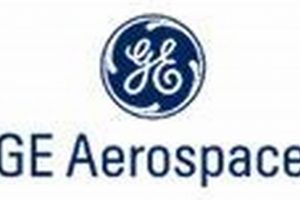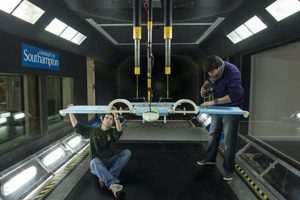This multidisciplinary field integrates principles of aircraft and spacecraft design with computational problem-solving techniques. It encompasses areas such as flight dynamics, propulsion systems, and control theory, while leveraging algorithms, data structures, and programming paradigms to model, simulate, and optimize complex systems. For instance, computational fluid dynamics simulates airflow around an aircraft wing, while embedded systems control spacecraft attitude and trajectory.
The convergence of these disciplines is critical for advancing technological capabilities in various sectors. It facilitates the development of more efficient and sustainable air travel, enables exploration of space with autonomous systems, and improves national security through sophisticated defense technologies. Historically, these fields evolved independently, but increasing computational power and the complexity of modern aerospace systems have necessitated their integration.
The following sections will delve into specific applications within autonomous navigation systems, examine recent advancements in artificial intelligence within flight control, and investigate the use of machine learning for predictive maintenance in aircraft engines.
Key Considerations for Integration
The effective combination of disciplines requires careful planning and execution. Understanding fundamental principles in both fields is crucial for success. Below are critical aspects to consider when engaging with the integration of air and space vehicle design and computational techniques.
Tip 1: Prioritize Foundational Knowledge: A strong understanding of aerodynamics, orbital mechanics, and control systems is essential. Equally important is a solid grounding in data structures, algorithms, and software engineering principles. This base enables effective cross-disciplinary communication and problem-solving.
Tip 2: Emphasize Model-Based Systems Engineering: Utilize MBSE approaches to define, design, analyze, and verify complex systems. This methodology promotes collaboration and facilitates the creation of robust and reliable solutions. The integration of models throughout the development lifecycle reduces errors and improves efficiency.
Tip 3: Master Simulation and Optimization Techniques: Proficiency in computational fluid dynamics, finite element analysis, and optimization algorithms is critical. These tools allow engineers to simulate real-world conditions and identify optimal designs. This significantly reduces the need for expensive physical prototyping.
Tip 4: Implement Robust Verification and Validation Processes: Rigorous testing and validation are paramount, ensuring that the integrated systems perform as intended under various operating conditions. Adherence to industry standards and regulatory requirements is crucial to prevent failures.
Tip 5: Leverage Cloud Computing and Big Data Analytics: Cloud platforms provide scalable resources for data storage and processing. Big data analytics techniques enable the extraction of valuable insights from sensor data, improving performance and safety. These insights drive predictive maintenance and anomaly detection efforts.
Tip 6: Stay Abreast of Emerging Technologies: Continuous learning is essential to remain current with advancements in areas such as artificial intelligence, machine learning, and autonomous systems. Exploring new technologies can lead to innovative solutions and competitive advantages. Consider the impact of quantum computing and blockchain applications.
The successful application of these considerations will lead to optimized designs, improved safety, and increased efficiency in projects. By embracing these practices, engineers can effectively bridge the gap between traditional approaches and modern computational capabilities.
The next section will explore real-world case studies that demonstrate successful implementations of the suggested tips.
1. Autonomous Flight Systems
Autonomous Flight Systems represent a significant intersection between aerospace engineering and computational expertise. The development and deployment of these systems rely heavily on principles derived from both disciplines, creating an interdependent relationship. The creation of a self-navigating aircraft, for example, requires sophisticated aerodynamic designs (aerospace engineering) coupled with complex algorithms for path planning and obstacle avoidance (computer science). The successful operation of such a system, therefore, is a direct result of the synergistic application of both fields.
The importance of Autonomous Flight Systems within the broader context of aerospace is multifaceted. These systems enhance efficiency by optimizing flight paths and reducing human error, leading to lower fuel consumption and safer operations. Unmanned aerial vehicles (UAVs) used for surveillance, package delivery, and infrastructure inspection are tangible examples of this significance. These applications demonstrate the practical value of merging air and space vehicle design with cutting-edge programming and computational modelling.
Challenges remain in ensuring the reliability and safety of these systems. Verification and validation processes must be robust, and cybersecurity concerns addressed to prevent unauthorized access or manipulation. Furthermore, the ethical implications of autonomous systems, such as decision-making in emergency situations, must be thoroughly considered. Overcoming these challenges is essential to realizing the full potential of Autonomous Flight Systems, solidifying the critical link between aerospace engineering and computer science in shaping the future of aviation and space exploration.
2. Computational Fluid Dynamics
Computational Fluid Dynamics (CFD) represents a cornerstone application of computational power within the broader field that integrates air and space vehicle design with advanced computational techniques. CFD employs numerical methods and algorithms to analyze and simulate fluid flows, playing a pivotal role in the design and optimization of aircraft, spacecraft, and related systems. The dependency is causal: advancements in CFD capabilities directly translate into improvements in aerodynamic performance, thermal management, and structural integrity, which are all essential for successful aerospace engineering projects. Examples include simulating airflow around aircraft wings to minimize drag and maximize lift, or modeling the combustion process within a rocket engine to improve efficiency and reduce emissions. The importance of CFD stems from its ability to provide detailed insights into fluid behavior that are often difficult or impossible to obtain through experimental testing alone.
The practical application of CFD extends beyond design. It is integral to certification processes, where simulations are used to demonstrate compliance with safety regulations. It also finds use in accident investigation, where CFD models can reconstruct airflow patterns to determine the cause of a failure. Additionally, CFD is increasingly being used in the development of advanced technologies such as hypersonic vehicles and plasma propulsion systems. The development of new algorithms and turbulence models allows for more accurate simulations of complex flow phenomena, expanding the utility of CFD in challenging engineering problems. This is reinforced through ongoing development of higher fidelity simulations that closely mimic empirical results.
In summary, CFD is an indispensable component, offering valuable insights, enhancing design processes, and supporting safety measures. Although challenges persist in accurately modeling complex phenomena such as turbulence and multiphase flows, ongoing advancements in numerical methods and computational power continually expand its capabilities. It is essential to acknowledge the significant interdisciplinary nature between air and space vehicle design and computational techniques, with CFD serving as a prime example of their symbiotic relationship.
3. Embedded System Control
Embedded System Control is a critical element within modern aerospace systems, representing a direct application of air and space vehicle design principles coupled with computational expertise. These systems, typically consisting of microprocessors, sensors, and actuators, manage specific functions within an aircraft or spacecraft, such as flight control surfaces, engine management, navigation, and communication. The reliability and performance of these systems are paramount to the overall safety and operational effectiveness of the vehicle. The functionality of an autopilot system, for example, requires precise embedded control algorithms to interpret sensor data (altitude, airspeed, attitude), compute necessary adjustments, and actuate control surfaces, maintaining stable flight without pilot intervention. The development and integration of these systems is a complex process that demands a thorough understanding of both aerospace engineering principles and advanced computing techniques.
The practical significance of Embedded System Control extends beyond basic functionality. Modern aerospace systems rely on intricate networks of embedded controllers to optimize performance, reduce fuel consumption, and enhance safety. Fly-by-wire systems, which replace mechanical linkages with electronic controls, are a prime example of this advanced application. These systems offer enhanced maneuverability and stability, allowing for more efficient aircraft designs. Additionally, embedded systems play a crucial role in spacecraft attitude control, ensuring precise orientation for communication, observation, and scientific experiments. The ongoing development of more powerful and efficient microprocessors, coupled with advancements in control algorithms, enables the implementation of increasingly sophisticated control strategies. Examples also include power management to the various subsystems located inside the aircraft such as in flight entertainment, lighting and sensors.
In summary, Embedded System Control is an indispensable component of contemporary aerospace engineering, bridging the gap between theoretical design and practical implementation. While challenges remain in ensuring the robustness and security of these systems, particularly in the face of cyber threats, their importance will only increase as aerospace systems become more complex and autonomous. A comprehensive understanding of this area is essential for any engineer working in the aerospace field, highlighting the symbiotic relationship between air and space vehicle design and computational technologies.
4. Data-Driven Optimization
Data-Driven Optimization represents a paradigm shift in aerospace engineering, directly connecting air and space vehicle design with computational techniques. This approach leverages vast datasets generated during design, testing, and operation to refine existing systems and create more efficient future designs. The efficacy of this optimization is a consequence of the ability to analyze complex relationships within the data, revealing patterns and insights that traditional methods might miss. For example, aircraft engine performance can be significantly improved by analyzing sensor data collected during flight, identifying areas for optimization in fuel consumption, emissions, and component wear. The importance of data-driven methods stems from their capacity to move beyond theoretical models, grounding decisions in real-world evidence and enhancing the accuracy and reliability of engineering outcomes.
The practical applications of Data-Driven Optimization are multifaceted. In aircraft design, it enables the creation of more aerodynamic airframes by analyzing wind tunnel test data and computational fluid dynamics simulations. This results in reduced drag, increased fuel efficiency, and improved flight performance. Similarly, in spacecraft development, data from satellite telemetry can be used to optimize orbital trajectories, maximize power generation from solar panels, and predict potential component failures. Furthermore, predictive maintenance algorithms, fueled by data from sensors embedded in aircraft systems, enable proactive repairs, minimizing downtime and enhancing safety. The ability to predict structural failures and schedule maintenance before issues arise enhances operational efficiency and reduces the risk of catastrophic events.
In conclusion, Data-Driven Optimization is a critical component driving advancements. While challenges persist in managing and analyzing large datasets, as well as ensuring the integrity and security of the data, the potential benefits are substantial. It underscores the importance of integrating air and space vehicle design with advanced computational expertise, paving the way for more efficient, reliable, and sustainable aerospace systems. This shift emphasizes the increased dependency on and relevance of the interdisciplinary approach.
5. Artificial Intelligence Integration
Artificial Intelligence Integration represents a transformative force reshaping aerospace engineering and computer science. The inclusion of AI algorithms and methodologies within aerospace systems fundamentally alters the way aircraft and spacecraft are designed, operated, and maintained. This integration is not merely additive; it creates synergistic capabilities that exceed the potential of either field in isolation. The deployment of AI in autonomous navigation, for example, enables unmanned aerial vehicles (UAVs) to adapt to unpredictable environments and make real-time decisions, surpassing the capabilities of traditional autopilot systems. Similarly, AI algorithms applied to flight control systems enhance stability, reduce pilot workload, and improve fuel efficiency through continuous optimization. This reliance on computation allows increased safety and performance.
Practical applications of AI Integration span a wide range of areas. In aircraft manufacturing, AI-powered robotic systems automate complex assembly processes, improving precision and reducing production time. Predictive maintenance systems use machine learning algorithms to analyze sensor data and identify potential component failures before they occur, minimizing downtime and enhancing safety. Furthermore, AI algorithms are being deployed in air traffic control systems to optimize flight routing, reduce congestion, and enhance overall system efficiency. The implementation of AI in spacecraft operations includes autonomous anomaly detection, resource management, and scientific data analysis. These examples demonstrate the potential for AI to not only improve existing aerospace systems but also to enable entirely new capabilities.
The ongoing integration of AI presents significant challenges, including the need for robust validation and verification processes to ensure the reliability and safety of AI-driven systems. Concerns surrounding cybersecurity and the potential for adversarial attacks on AI algorithms must also be addressed. However, the transformative potential of AI to revolutionize aerospace engineering and computer science is undeniable. By continuing to address these challenges and investing in research and development, the full potential of AI Integration can be realized, leading to safer, more efficient, and more sustainable aerospace systems.
6. Predictive Maintenance Algorithms
The implementation of predictive maintenance algorithms represents a significant advancement in the aerospace industry, directly resulting from the convergence of aerospace engineering principles and computer science methodologies. This approach focuses on analyzing data to forecast potential equipment failures, allowing for proactive maintenance interventions and minimizing operational disruptions.
- Data Acquisition and Sensor Technology
Effective predictive maintenance relies on the collection of comprehensive data from various sensors embedded within aircraft systems. These sensors monitor parameters such as vibration, temperature, pressure, and oil quality. The selection and placement of these sensors require expertise in both aerospace engineering understanding the critical components and failure modes of the aircraft and computer science designing the data acquisition systems and ensuring data integrity. For example, accelerometers placed on engine turbine blades can detect subtle changes in vibration patterns, indicating potential imbalance or wear. The data collected are then transmitted to a central processing unit for analysis.
- Algorithm Development and Machine Learning
The core of predictive maintenance lies in the algorithms used to analyze the sensor data and predict potential failures. Machine learning techniques, such as neural networks and support vector machines, are frequently employed to identify patterns and anomalies that may indicate impending equipment malfunctions. These algorithms require significant computational resources and expertise in data science and machine learning. For instance, a neural network can be trained on historical data of engine failures to predict the remaining useful life of an engine based on its current operating conditions. The complexity of these algorithms necessitates a strong foundation in computer science principles.
- System Integration and Implementation
Integrating predictive maintenance algorithms into existing aerospace systems requires careful planning and execution. The algorithms must be seamlessly integrated with the aircraft’s avionics and maintenance management systems. This requires expertise in both aerospace engineering understanding the architecture and communication protocols of the aircraft and computer science developing the software interfaces and ensuring compatibility. For example, the predictive maintenance system might be integrated with the aircraft’s electronic flight bag (EFB) to provide pilots and maintenance personnel with real-time information on the health of the aircraft systems.
- Validation and Verification
Ensuring the accuracy and reliability of predictive maintenance algorithms is critical. This involves rigorous validation and verification processes, including extensive testing and simulation. The algorithms must be validated against historical data and real-world operating conditions to ensure that they accurately predict failures. This requires expertise in both aerospace engineering understanding the potential failure modes and their consequences and computer science developing the testing protocols and analyzing the results. For instance, simulations can be used to model different failure scenarios and assess the performance of the predictive maintenance algorithms.
These facets underscore the intertwined relationship of air and space vehicle design with advanced computational techniques in predictive maintenance. By combining knowledge from both disciplines, it becomes possible to significantly improve the safety, reliability, and efficiency of aerospace operations, leading to reductions in maintenance costs and improved aircraft availability. The ongoing advancements in sensor technology, machine learning, and data analytics will further enhance the capabilities of predictive maintenance algorithms, solidifying their importance in the aerospace industry.
7. Cybersecurity in Aviation
The increasing reliance on interconnected systems within modern aviation necessitates a heightened focus on cybersecurity. The integration of air and space vehicle design with advanced computational techniques has expanded the attack surface, requiring robust security measures to protect aircraft, ground infrastructure, and passenger data. Effective cybersecurity strategies require a deep understanding of both aerospace systems and information technology, highlighting the interdependence of these fields.
- Aircraft Systems Security
Aircraft increasingly rely on digital systems for critical functions such as flight control, navigation, and communication. These systems are vulnerable to cyberattacks that could compromise aircraft safety and performance. Examples include the potential for unauthorized access to flight management systems, disruption of communication links, or manipulation of sensor data. Mitigation strategies involve secure coding practices, intrusion detection systems, and hardware-based security measures. The design and implementation of these safeguards require collaboration between aerospace engineers who understand the intricacies of aircraft systems and computer scientists skilled in cybersecurity principles.
- Air Traffic Control Infrastructure
Air traffic control (ATC) systems are essential for the safe and efficient management of air traffic. These systems are interconnected and rely on digital communication networks, making them a potential target for cyberattacks. Disruptions to ATC systems could lead to flight delays, rerouting of aircraft, and increased risk of accidents. Cybersecurity measures for ATC include robust authentication protocols, network segmentation, and incident response plans. The protection of ATC infrastructure requires a comprehensive approach that combines aerospace expertise understanding the operational requirements of air traffic control with computer science skills securing networks and preventing unauthorized access.
- Passenger Data Protection
Airlines collect and store vast amounts of passenger data, including personal information, travel history, and payment details. This data is vulnerable to cyberattacks and data breaches, which can have serious consequences for passengers and airlines. Cybersecurity measures for passenger data protection include encryption, access controls, and compliance with data privacy regulations. Protecting passenger data requires a deep understanding of both aerospace regulations and cybersecurity best practices, necessitating collaboration between experts from both fields.
- Supply Chain Security
The aviation supply chain involves numerous vendors and suppliers who provide components, software, and services to airlines and manufacturers. This complex supply chain is vulnerable to cyberattacks that could compromise the integrity of aircraft systems. Examples include the insertion of malicious code into software updates or the counterfeiting of critical components. Cybersecurity measures for supply chain security include vendor risk management, secure software development practices, and supply chain monitoring. Ensuring the security of the aviation supply chain requires a holistic approach that integrates aerospace engineering and computer science expertise.
The aforementioned examples illustrate the critical interdependence between aerospace engineering and computer science in addressing cybersecurity challenges within the aviation domain. By integrating knowledge and skills from both disciplines, it is possible to develop robust security measures that protect aircraft, infrastructure, and passenger data. Continuous vigilance and proactive security measures are essential to maintaining the safety and integrity of the aviation ecosystem.
Frequently Asked Questions
The following addresses common inquiries regarding the integration of air and space vehicle design with advanced computational technologies. This information aims to clarify misconceptions and provide a foundation for understanding the complexities of this interdisciplinary field.
Question 1: What are the fundamental skill sets required to succeed in the convergence of aerospace engineering and computer science?
Proficiency requires a robust understanding of core aerospace principles, including aerodynamics, propulsion, and structural mechanics. Simultaneously, a strong foundation in computer science is essential, encompassing data structures, algorithms, software engineering, and cybersecurity. Expertise in mathematical modeling and simulation is also vital.
Question 2: How does computational fluid dynamics (CFD) contribute to advancements in aircraft design?
CFD allows engineers to simulate airflow around aircraft components, enabling optimization of aerodynamic performance. It facilitates the identification and mitigation of drag-inducing features, leading to increased fuel efficiency and improved flight characteristics. CFD analysis reduces the need for extensive physical testing, accelerating the design process and reducing costs.
Question 3: What role does artificial intelligence (AI) play in modern aerospace systems?
AI is implemented in diverse applications, including autonomous navigation, flight control optimization, predictive maintenance, and anomaly detection. AI algorithms analyze vast datasets to identify patterns and make real-time decisions, enhancing safety, efficiency, and reliability. However, rigorous validation and verification are essential to ensure the robustness of AI-driven systems.
Question 4: Why is cybersecurity a critical concern in aviation?
Modern aircraft rely on interconnected digital systems for essential functions, making them vulnerable to cyberattacks. Unauthorized access to flight control systems, disruption of communication networks, or manipulation of sensor data could compromise aircraft safety and performance. Robust cybersecurity measures are imperative to protect aircraft, ground infrastructure, and passenger data.
Question 5: How are data-driven methods used to optimize aerospace systems?
Data-driven optimization leverages large datasets generated during design, testing, and operation to refine existing systems and create more efficient future designs. Machine learning algorithms analyze sensor data to identify areas for improvement in fuel consumption, emissions, component wear, and overall system performance. These methods enhance accuracy and reliability by grounding decisions in real-world evidence.
Question 6: What are the ethical considerations associated with the integration of artificial intelligence into aerospace systems?
The deployment of AI in safety-critical applications raises complex ethical questions. Issues such as autonomous decision-making in emergency situations, accountability for system failures, and potential biases in AI algorithms must be carefully considered. Ethical frameworks and regulations are needed to ensure that AI is used responsibly and in a manner that prioritizes human safety and well-being.
The integration of air and space vehicle design with advanced computational technologies offers significant opportunities for innovation and advancement. However, it also presents challenges related to technical expertise, security, ethics, and regulation. A comprehensive understanding of these issues is essential for navigating the complexities of this evolving field.
The subsequent section will delve into case studies illustrating successful implementations of these integrated approaches within specific aerospace applications.
Conclusion
The preceding exploration underscores the synergistic relationship. It is through the deliberate integration of fundamental engineering principles with computational expertise that advancements in air and space vehicle technology are realized. From optimized aerodynamic designs enabled by Computational Fluid Dynamics to autonomous flight systems driven by Artificial Intelligence, these symbiotic partnerships are reshaping possibilities.
Continued focus on research, development, and education within the convergence of aerospace engineering and computer science remains critical. The future necessitates a workforce proficient in both domains, capable of navigating the complex challenges and capitalizing on the emerging opportunities. Maintaining a commitment to rigorous standards, ethical considerations, and a systems-thinking approach will ensure that this integration continues to drive innovation and enhance the safety, efficiency, and sustainability of air and space travel.







